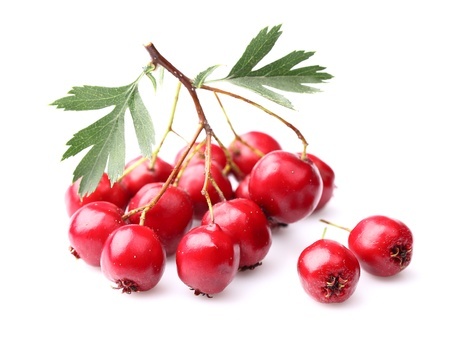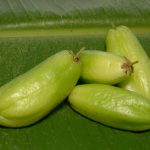
Hawthorn (Crataegus monogyna) amongst many species in the genus produced a berry fruit that characterises late summer and autumn with its red spattering of bushes. Whilst it is a great favourite of birds, the dried fruit and other extracts are recommended by herbalists for treatment of a variety of heart and cardiovascular related issues including palpitations and blood pressure.
Extracts in Chinese medicine are taken from the Crataegus pinnatifida var. Major, fruit.
History behind Using Hawthorn Extracts
Hawthorn twigs are extremely spiny and thorny (hence the name) and it was reputedly used to make Jesus’ ‘crown of thorns’ so Christianity has created an association between Hawthorn and bad luck. On top of that unlucky reputation, some European species of Hawthorn emit a nasty smell from their flowers which hasn’t helped the plants public image. Having acquired this reputation, the Celts contradicted this by believing hawthorn was a symbol of enduring love.
The plant is also known as Aubepine, Aubépine, Aubépine Blanche, Aubépine Épineuse, Bianco Spino, Bois de Mai, and Cenellier.
Hawthorn species grow throughout Europe and Northern Asia.
Components in Hawthorn Fruit
The following have been found in fruit extracts:- chlorogenic acid, procyanidin B2, (−)-epicatechin, rutin, and isoquercitrin (Zhang et al., 2013).
May Help In The Reduction Of Cholesterol
Some animal studies indicate that hawthorn extracts might reduce LDL cholesterol which is regarded as ‘bad’ cholesterol in medical terms. An ethanolic extract from hawthorn known as cv. Zhongtian which is a cultivar of ‘Shan-Zia’, reduced both LDL- and total cholesterol levels, as well as total lipids including triglycerides as part of a body weight reduction study (Hu et al., 2016). It might be a potential treatment for hyperlipidaemia.
The hawthorn pectin, pentaoligosaccharide (HPPS) is also shown to perform the following in a mouse study. This was to suppress weight gain, decrease serum triglyceride (TG) levels, increase lipid excretion in feces, upregulate the gene and protein expressions of peroxisome proliferator-activated receptor α (PPAR-a), and enhance the hepatic fatty acid oxidation-related enzyme activities of a number of enzymes required for liver function. These included acyl-CoA oxidase, carnitine palmitoyltransferase I, 3-ketoacyl-CoA thiolase, and 2,4-dienoyl-CoA reductase (Li et al., 2013).
Availability
The dried berries are available from herbal suppliers and whole food shops in 50g and 100g amounts. Please note this article contains links to our affiliate marketing partner. Please refer to our affiliate disclosure.
Purchase your hawthorn extracts here
Uses
- Research in Germany has suggested Hawthorn has benefits for the cardio-vascular system. It is claimed to strengthen the heart and stabilise it against arythmias and to lower blood pressure.
- It may reduce chest pain from angina
- Hawthorn is rich in antioxidants which are thought to reduce the damaging effects of ‘free radicals’ in the body
- Some herbalists believe it ‘opens up’ the coronary arteries improving the heart’s blood supply.
- There is some association with reduction of inflammation.
How To Prepare Hawthorn Extracts
To drink as an infusion steep two teaspoons of crushed leaves or berries in a cup of boiling water for up to 20 minutes, no more than twice per day Can also be enjoyed as a teaspoon of tincture at the beginning and the end of the day Hawthorn is quite bitter but can be mixed with sugar or honey to sweeten it up.
Cautionary Information
- Some herbalists suggest limiting doses and usage to avoid light headedness or lowering the blood pressure too far.
- Interacts with prescription medicines taken for heart disease and sexual dysfunction. Specific medications which are suspected of interacting with hawthorn include beta-blockers, calcium channel blockers (CCBs), digoxin, nitrates, phenylephrine and phosphodiesterase-5 inhibitors. (Refer to articles by WebMd for side effects and interactions).
- Always consult a medical professional if you have a serious condition of any type especially related to heart disease and hypertension
- Do not give to any child under two years old
- Do not use while pregnant or nursing.
References
Hu, H.J.; Luo, X.G.; Dong, Q.Q.; Mu, A.; Shi, G.L.; Wang, Q.T.; Chen, X.Y.; Zhou, H.; Zhang, T.C.; Pan, L.W. (2016) Ethanol extract of Zhongtian hawthorn lowers serum cholesterol in mice by inhibiting transcription of 3-hydroxy-3-methylglutaryl-CoA reductase via nuclear factor-kappa B signal pathway. Exp. Biol. Med. 241, pp. 667–674. PMID: 26825354 PMCID: PMC4950330 DOI: 10.1177/1535370215627032
Li, T.P.; Zhu, R.G.; Dong, Y.P.; Liu, Y.H.; Li, S.H.; Chen, G. (2013) Effects of pectin pentaoligosaccharide from hawthorn (Crataegus pinnatifida Bunge. Var. Major) on the activity and mRNA levels of enzymes involved in fatty acid oxidation in the liver of mice fed a high-fat diet. J. Agric. Food Chem. 61, pp. 7599–7605. PMID: 23855516 DOI: 10.1021/jf400283w
Zhang, J.; Liang, R.; Wang, L.; Yan, R.; Hou, R.; Gao, S.; Yang, B. (2013) Effects of an aqueous extract of Crataegus pinnatifida Bge. Var. Major N.E.Br. fruit on experimental atherosclerosis in rats. J. Ethnopharmacol. 148, pp. 563–569. PMID: 23685195 DOI: 10.1016/j.jep.2013.04.053
Zhang, Y.Y.; Zhang, L.; Geng, Y.; Geng, Y.H. (2014) Hawthorn fruit attenuates atherosclerosis by improving the hypolipidemic and antioxidant activities in apolipoprotein E-Deficient mice. J. Atheroscler. Thromb. 21, pp. 119–128. PMID: 24126122


Leave a Reply